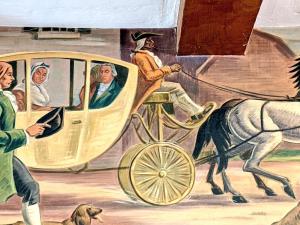 Staatsburg, N.Y. — Stephen. Belinda. Mary. William. Dinah. Those are the known names of the nine people New York State governor Morgan Lewis enslaved at his country estate, Staatsburgh. What do we know of their lives in the Hudson Valley and the legacy of slavery within New York today?
Staatsburg, N.Y. — Stephen. Belinda. Mary. William. Dinah. Those are the known names of the nine people New York State governor Morgan Lewis enslaved at his country estate, Staatsburgh. What do we know of their lives in the Hudson Valley and the legacy of slavery within New York today?
Staatsburgh State Historic Site is offering their free, one-hour program “Slavery, Segregation & Staatsburgh” on August 26 & 27 at 2:00 p.m. and again on September 4 (Labor Day) at 2:00 p.m. Staatsburgh’s founder, Morgan Lewis, enslaved people of African descent at Staatsburgh. Yet, when his great-granddaughter, Ruth Livingston Mills, lived at Staatsburgh at the turn of the 20th century, the staff was exclusively White and of European descent. At the same time, a free Black community was able to grow and thrive in the surrounding hamlet.
“Slavery, Segregation & Staatsburgh” is a conversation, led by site staff, exploring the transition from a Black presence at Staatsburgh during the early 19th century to the apparent absence of Black people at the estate during the Gilded Age. This one-hour program will include historic photographs and documents related to this history, notably a letter from Staatsburgh’s archives written by “Founding Father,” John Jay, discussing his 1790 purchase of an enslaved man named Peter Williams, from Morgan Lewis. The presentation will focus on recent research into the Black people living and working at the Staatsburgh estate and in the neighboring hamlet of Staatsburg, bringing in the larger context of racial oppression and Jim Crow, to present audiences with a new perspective on Staatsburgh.
The program is free, but reservations are required at https://www.Bookeo.com/StaatsburghSHS. Staatsburgh State Historic Site will be open for tours on Labor Day (Monday, September 4) in addition to regular Thursday through Sunday tour offerings now through October. Tours and programs will be offered by advance reservation only; reservations can be made at https://www.Bookeo.com/StaatsburghSHS. Visitors may also enjoy a stroll by the Hudson River or a hike along the woodland trails in adjacent in Mills Memorial State Park.
“Slavery, Segregation & Staatsburgh” and Staatsburgh’s blog essay series, Enslaved & In Service, are presented within the larger New York State Office of Parks, Recreation, and Historic Preservation’s “Our Whole History” initiative, which aims to explore indigenous, Black, LGBTQ+, and other stories still untold by historic sites throughout the state. “Our Whole History” seeks to bring a more balanced historic narrative to public awareness, enriching both our state’s history and the stories we share throughout the historic site system. Through ongoing research and new interpretations, the agency seeks to create a more inclusive environment, more reflective of our multicultural past, and welcoming to all.
Staatsburgh State Historic Site and the Ogden Mills & Ruth Livingston Mills Memorial State Park are located on Old Post Road in Staatsburg, off Route 9 between Rhinebeck and Hyde Park. The historic site is one of 6 sites and 15 parks administered by the Taconic Region of New York State Office of Parks,
Recreation and Historic Preservation. For more information, call 845-889-8851, or visit Staatsburgh’s websites at Parks.NY.gov, Facebook, and Blogger. Staatsburgh’s events are listed at Parks.NY.gov/Events.
New York State Office of Parks, Recreation and Historic Preservation oversees more than 250 individual parks, historic sites, recreational trails, and boat launches, which were visited by a record 79.5 million people in 2022. For more information on any of these recreation areas, call 518-474-0456 or visit parks.ny.gov, connect on Facebook, or follow us on Twitter
###
Image: Detail of mural from Rhinebeck Post Office, by Olin Dows, 1940, showing a coachman, probably a person enslaved by members of the Livingston family.
Contact: Zack Veith | Zachary.Veith@parks.ny.gov | 845-889-8851 ext. 355
 NEWSLETTER
NEWSLETTER
